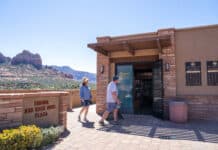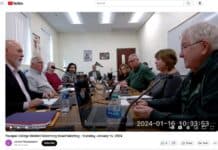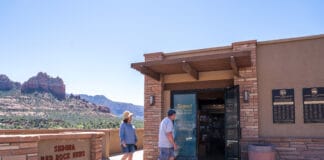It’s no secret that warmer weather brings with it more visitors who want to experience everything the Sedona area has to offer. But with an increase in outdoor activity often comes a greater needed for assistance.
In the end of June, the Sedona Fire District responded to 11 back country rescue calls in eight days. And for the month of June, they took part in 24 back country rescues, two and a half times more than June of last year.
“While the summer season brings us more trail rescues, they seem to be happening with more regularity this year,” Chief Kris Kazian said, noting that these types of calls are typically long duration and labor intensive. “It usually takes at least six personnel, sometimes more, to effect a trail rescue. This can take three apparatus out of service for up to five hours in some cases.”
This is troubling because there are times when SFD crews are performing more than one back country rescue at the same time, he said. Capt. Ralph Kurtz said most of the rescues are due to the fact that people are ill-prepared.
“They are oblivious to the danger that they are putting themselves in,” he said. “There have been many times when we are carrying a patient out on the trail and we encounter hikers heading in and we ask them if they have water. It amazes me how many times they will hold up a half empty bottle of water and that is all that they have with them.”
According to the SFD, the rule of thumb for hydrating in the desert is to drink the number that is half of your body weight in ounces of water every day. This amount should increase if you are going to be physically active.
For those looking to take advantage of the 250-plus miles of trails the area has to offer, SFD officials have a few simple rules to help you stay out of trouble.
- Water: Take plenty of it, more than you think you need, and then throw in an extra bottle just in case.
- Phone: Make sure it is fully charged and take it with you. n Food: Even if you only plan to be out for a short walk, throw a couple of energy bars in your pack.
- Survival: A space blanket and a signaling mirror take up virtually no space in your day pack and can mean the difference between survival and disaster.
- Inform: Let someone know your plans, where you are going and when you plan to return. n Take a buddy: Never hike alone. If something happens to one of you, the other can get help.
- Stay put: If something happens and you have to call for help, find some shade and stay put. It is much harder for rescuers to find you if you continue to move.
“We want people to hike responsibly and enjoy everything that Sedona has to offer,” Kurtz said. “They need to remember that everything in the desert is hostile, from the plants and animals to the environment. You must plan well to survive when all of the other factors are working against you.”
Not Just in Sedona The jump in the number of rescues isn’t just limited to the Sedona Fire District as of late. The Coconino County Sheriff’s Office has seen a dramatic increase, as well. According to Cmdr. Rex Gilliland, so far this year they have responded to more than 60 search and rescue calls, compared to 90 all of last year.
“We do have some idea as to why we’re seeing an increase,” he said. “It’s the fact that Northern Arizona has so much to offer from a recreational standpoint. We started saying, ‘We’re being loved to death.’ But it’s not just us. Everyone is seeing an increase in rescues across the board. And here in Flagstaff, we’re a big draw this time of the year because we’re 20 to 25 degrees cooler that most places.”
Gilliland said on an average year they will get more than 300 calls for search and rescue. However, more than two-thirds of those calls are handled by the deputies, while the volunteer SAR team handled the rest. Like other neighboring agencies, CCSO and SFD often work together on calls.
In terms of when CCSO requests assistance from SFD, Gilliland said it varies. If a call comes in for a missing or stranded hiker, normally SFD is not called in. But if there is a medical need, he said their assistance will be requested.
“It really depends on the nature of the call,” he said. “In those cases where medical attention is required they will assist with that and extraction from the scene. It’s definitely a joint effort. There have also been those times when we’ve been tied up on multiple calls and our resources are just stretched too thin. That’s when we’ll request assistance from other agencies like Sedona or the U.S. Forest Service.”
Gilliland added that while technology is a positive thing, often hikers rely too heavily on having a cell phone or GPS. Because of that, they are unprepared for the hike or the elements since they have a false sense of security knowing they can call for help if needed.
“In the past, when someone was going into the back country they’d prepare for any situation,” he said. “Nowadays, we find people who go out with nothing but a small bottle of water and cell phone. Sometimes it’s just a matter of using common sense.”
| Trail Times |
|
Following are the 11 back country rescue calls the Sedona Fire District responded to from June 17 to 25.
|


















